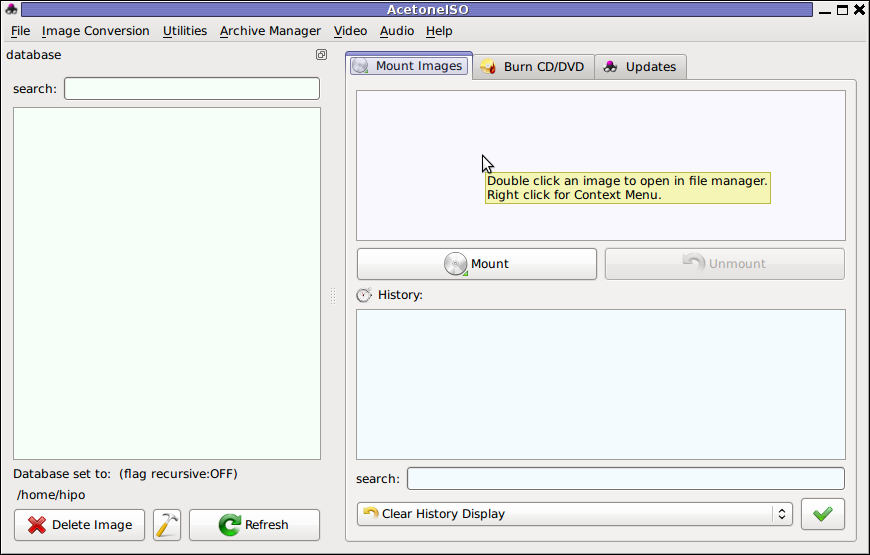

- #LINUX ISO FILE MOUNT HOW TO#
- #LINUX ISO FILE MOUNT INSTALL#
- #LINUX ISO FILE MOUNT ARCHIVE#
- #LINUX ISO FILE MOUNT SOFTWARE#
The file system type of the ISO file can be specified explicitly. sudo -o loop /home/ismail/ubuntu.iso /mnt/isoīy default the ISO file file system type is automatically detected by the mount command. Now we can mount the ISO file but again we require the root privileges. First we will create a directory named /mnt/iso to mount ISO file. The /mnt directory requires root privielges to mount or create directory. Unmount the ISO file after it has been verified: select ls -l /mnt/iso/Unmount the ISO file using ullymount /mnt/iso/. Slivice: sudo mount -o loop /path/to/my-iso-image to mount the ISO file on Linux.

Click the folder in which your ISO is stored (e.g., Downloads) on the left side of the File Explorer, then open any additional folders in the main window until you arrive at your ISO file. An ISO file can be mounted on Linux in its own mount point directory: sudo mkdir /mnt/iso. Generally physical CD-ROM and ISO files are mounted under the /mnt directory. Click the folder icon in the lower-left side of the Start window. mount -o loop /home/ismail/ubuntu.iso /home/ismail/cdrom Following ISO mount operation does not require root privileges because the current user has access rights for his/her home directory. We provide the -o loop option and do not provide the sudo command. In the following example, the ISO file named ubuntu.iso mounted into cdrom directory located in the current user home directory. To mount the ISO file a mount point is required where the contents of the ISO represented. As an ISO file is a file system defined as ISP 9660 or UDF we can use the mount command in order to mount ISO files. The mount command is used to mount different disks and partitions with different file systems. The instructions on this section should work on any Linux distribution, including Ubuntu, Debian, and CentOS. UDF is backward compatible with the ISO 9660. The mount command allows you to attach (mount) ISO files at a particular mount point in the directory tree. The UDF is the next version of the ISO 9660 standard. Create a mount point (/mnt/iso) to access an ISO image (Click on picture below to enlarge it). ISO 9660 standard created in order to make every CD and DVD content compatible. Mount using Command Line Interface (CLI) To mount an ISO image in Linux, you must be a root or sudo privileges access. The mount command, as the name suggests, allows you to mount a variety of filesystems. After mounting these ISO image files, you will be able to browse their contents and copy / extract data from the mount point to your local file system. ISO is a file format and file system which is also defined as ISO 9660. This article will list a few methods using which you can mount ISO image files in Linux.
#LINUX ISO FILE MOUNT SOFTWARE#
Generally, operating systems, software, software bundles are stored inside ISO files. Mount the ISO file to the mount point by typing the following command: sudo mount /path/to/image.iso /media/iso -o loop. Start by creating the mount point, it can be any location you want: sudo mkdir /media/iso. ISO files contain the image of a specific CD or DVD. How do I mount a file in Linux Mounting ISO Files.
#LINUX ISO FILE MOUNT HOW TO#
In this tutorial, we will learn how to mount (attach) a drive in Linux with the EXT Linux file system, FAT or NTFS using mount command.

The following is an example command to load a drive 0 from an image.iso: cdemu load 0 /home/nur/images/image.ISO is a popular file format that is generally used to store optical media data like CDs, DVDs, etc. Mount is a command used in Linux to attached filesystems and drives and umount command is used to detach (unmount) any attached file systems or devices. Another method involves selecting it by clicking or tapping on it.

The fastest way to open it is to double-click (or double-tap) on the ISO file. We used the ISO for Ubuntu Linux for this tutorial. The corresponds to the internal number of drives loaded by CDemu (per default 2 drives, change this in /etc/default/cdemu-daemon to a higher number if needed. First, open File Explorer and navigate to the '.iso' file that you want to open. To mount an ISO file as CD we can then issue: cdemu load
#LINUX ISO FILE MOUNT INSTALL#
We can then install the CDemu client and the CDemu daemon with sudo apt-get update & sudo apt-get install cdemu-daemon cdemu-clientĪfter logging out and back in, or a reboot, the daemon will be started. In this tutorial, we will explain how to mount ISO files on Linux.
#LINUX ISO FILE MOUNT ARCHIVE#
The application can be installed by adding the following ppa to our sources: An ISO file is an archive file that typically contains the complete image of a CD or DVD disc. Therefore the image does not need to be in ISO format. Amongst ISO a wide variety of other formats are supported. We sucessfully mounted CD or DVD images for application installation in Wine or for running an application which needs access to its CD using CDemu.


 0 kommentar(er)
0 kommentar(er)
